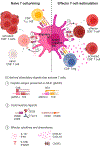Once upon a prime: DCs shape cancer immunity
- PMID: 36357313
- PMCID: PMC10827483
- DOI: 10.1016/j.trecan.2022.10.006
Once upon a prime: DCs shape cancer immunity
Abstract
Cytotoxic CD8+ T cells are potent killers of diseased cells, but their functional capacity is often compromised in cancer. The quality of antitumor T cell immunity is determined during T cell priming in the lymph node and further influenced by the local microenvironment of the tumor. Increasing evidence indicates that dendritic cells (DCs) have the capacity to precisely regulate the functional quality of antitumor T cell responses in both locations. In this review, we discuss recent advances in our understanding of how distinct DC-derived signals influence CD8+ T cell differentiation and antitumor functions. Insight into the mechanisms of DC-mediated regulation of antitumor immunity could inspire the development of improved approaches to prevent and reverse T cell dysfunction in cancer.
Keywords: T cell priming; antitumor immunity; cancer immunotherapy; cytotoxic T cells; dendritic cells; stimulatory signals.
Copyright © 2022 Elsevier Inc. All rights reserved.
Conflict of interest statement
Declaration of interests S.S. is an SAB member for Related Sciences, Arcus Biosciences, and Venn Therapeutics. S.S. is a cofounder of Danger Bio. S.S. is a consultant for TAKEDA, Merck, Tango Therapeutics, and Ribon Therapeutics and receives funding for unrelated projects from Leap Therapeutics.
Figures


References
-
- Chen DS and Mellman I (2017) Elements of cancer immunity and the cancer-immune set point. Nature 541 (7637), 321–330. - PubMed
Publication types
MeSH terms
Grants and funding
LinkOut - more resources
Full Text Sources
Medical
Research Materials

